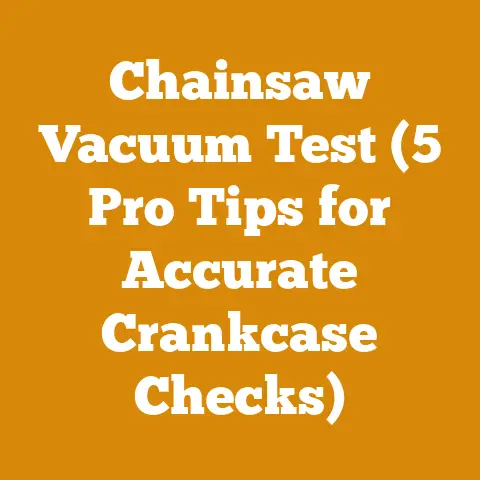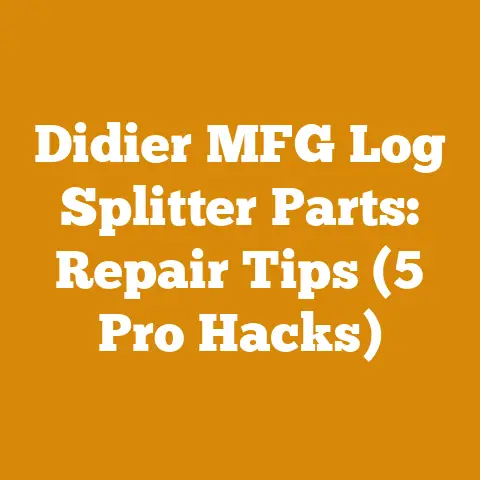Homemade Simple Pole Barn Tips (Creosote & Ground Fixing Secrets)
I still remember the first time I helped my grandpa build a small shed. It wasn’t much, but the sense of accomplishment was immense. That experience sparked a lifelong passion for woodworking and construction, leading me to explore everything from simple sheds to more complex structures like pole barns. Today, I want to share some of my experiences and tips on building a simple, homemade pole barn, focusing on two crucial aspects: creosote treatment and ground fixing. These elements are critical for the longevity and stability of your pole barn, and getting them right can save you a lot of headaches down the road.
Homemade Simple Pole Barn Tips (Creosote & Ground Fixing Secrets)
Building a pole barn yourself can be a rewarding experience, providing you with a versatile structure for storage, workshops, or even animal shelters.
Understanding the Basics of Pole Barn Construction
Before diving into creosote treatment and ground fixing, let’s cover the fundamental principles of pole barn construction. A pole barn, also known as a post-frame building, uses large posts or poles embedded in the ground to provide structural support. These poles act as the foundation, eliminating the need for a traditional concrete foundation in many cases.
- Framing: The poles are connected by horizontal beams (girts) and roof trusses, creating a sturdy frame.
- Cladding: The frame is then clad with metal siding, wood, or other materials to enclose the structure.
- Simplicity: The simplicity of this design makes it a popular choice for DIY projects.
Why Creosote Treatment Matters
Creosote is a wood preservative that has been used for centuries to protect timber from decay caused by fungi, insects, and moisture. For pole barns, where the posts are in direct contact with the ground, creosote treatment is crucial for extending the lifespan of the structure.
The Science Behind Creosote
Creosote is a complex mixture of chemicals derived from the distillation of coal tar or wood tar. These chemicals are toxic to the organisms that cause wood decay, effectively preventing rot and insect damage.
- Penetration: Creosote penetrates deep into the wood fibers, creating a protective barrier.
- Longevity: Properly treated wood can last for decades, even in harsh environments.
Types of Creosote
While creosote is a general term, there are different types available, each with its own properties and applications.
- Coal Tar Creosote: This is the most common type and is highly effective for preserving wood in ground contact.
- Wood Tar Creosote: Derived from wood, this type is less toxic but also less effective than coal tar creosote.
- Creosote Alternatives: Due to environmental concerns, some alternatives like copper naphthenate are available, but they may not offer the same level of protection as traditional creosote.
My Personal Experience with Creosote
I’ve used creosote on several pole barn projects, and I’ve seen firsthand the difference it makes. On one project, I decided to experiment by using untreated posts for a small section of the barn. Within just a few years, those posts showed signs of rot, while the creosote-treated posts remained in excellent condition. This experience solidified my belief in the importance of proper wood preservation.
Applying Creosote: A Step-by-Step Guide
Applying creosote correctly is essential for maximizing its effectiveness. Here’s a step-by-step guide based on my experience.
-
Preparation:
- Wood Selection: Choose pressure-treated lumber that is suitable for ground contact.
- Cleaning: Ensure the wood is clean and dry before applying creosote. Remove any dirt, debris, or loose bark.
- Safety Gear: Wear appropriate safety gear, including gloves, eye protection, and a respirator. Creosote can be harmful if inhaled or comes into contact with skin.
-
Application Methods:
-
Brushing: This is the most common method for DIY projects. Apply creosote liberally to the wood surface using a brush.
- Spraying: Spraying can be faster for large areas, but it requires more safety precautions to avoid inhalation.
- Dipping: This is the most effective method for ensuring deep penetration. Submerge the wood in a creosote bath for several hours or days.
-
Application Process:
-
Multiple Coats: Apply at least two coats of creosote, allowing each coat to dry completely before applying the next.
- End Grain Treatment: Pay special attention to the end grain of the wood, as this is where moisture is most likely to enter.
- Ground Line Treatment: Focus on the area of the post that will be buried in the ground, as this is the most vulnerable to decay.
-
Drying and Curing:
-
Drying Time: Allow the creosote to dry completely before installing the posts. This may take several days or weeks, depending on the weather conditions.
- Curing: The creosote will continue to cure over time, becoming more effective as it penetrates deeper into the wood.
Creosote Application: Dos and Don’ts
- Do: Use high-quality creosote specifically designed for wood preservation.
- Do: Follow the manufacturer’s instructions carefully.
- Do: Apply creosote in a well-ventilated area.
- Don’t: Apply creosote to wet or frozen wood.
- Don’t: Use creosote on wood that will come into direct contact with food or drinking water.
- Don’t: Dispose of creosote improperly. Follow local regulations for hazardous waste disposal.
Safety Precautions When Working with Creosote
Creosote is a hazardous material, and it’s essential to take precautions when handling it.
- Ventilation: Work in a well-ventilated area to avoid inhaling fumes.
- Protective Gear: Wear gloves, eye protection, and a respirator to protect your skin and respiratory system.
- Skin Contact: If creosote comes into contact with your skin, wash it off immediately with soap and water.
- Eye Contact: If creosote gets into your eyes, flush them with water for at least 15 minutes and seek medical attention.
- Storage: Store creosote in a tightly sealed container in a cool, dry place, away from children and pets.
Real-World Example: Creosote Treatment in a Coastal Environment
I once worked on a pole barn project near the coast, where the combination of salt air and high humidity created a particularly challenging environment for wood preservation. We used a combination of pressure-treated lumber and multiple coats of creosote to ensure the posts would withstand the harsh conditions. After several years, the barn is still in excellent condition, demonstrating the effectiveness of proper creosote treatment.
Takeaway:
Creosote treatment is a critical step in building a durable pole barn. By following these guidelines and taking the necessary safety precautions, you can protect your investment and ensure the longevity of your structure.
Ground Fixing: Ensuring a Solid Foundation
The way you fix your poles into the ground is just as important as the wood treatment. A poorly anchored pole barn can be susceptible to wind damage, soil erosion, and structural instability.
Understanding Soil Types and Their Impact
The type of soil on your property will significantly affect the way you fix your poles into the ground. Different soil types have different load-bearing capacities and drainage characteristics.
- Clay Soil: Clay soil is dense and holds water well, but it can also expand and contract with changes in moisture content. This can put stress on the poles and lead to movement over time.
- Sandy Soil: Sandy soil drains well but has poor load-bearing capacity. Poles in sandy soil may require additional support to prevent sinking or shifting.
- Loamy Soil: Loamy soil is a mixture of clay, sand, and silt, offering a good balance of drainage and load-bearing capacity. This is generally the ideal soil type for pole barn construction.
- Rocky Soil: Rocky soil can make digging difficult, but it can also provide good drainage. However, large rocks can interfere with the proper setting of the poles.
Assessing Your Soil
Before starting your pole barn project, it’s essential to assess your soil type and its properties. You can do this by:
- Visual Inspection: Examine the soil in your area to determine its texture and composition.
- Soil Testing: Conduct a soil test to determine the soil’s pH, nutrient content, and load-bearing capacity. You can purchase soil testing kits online or through your local agricultural extension office.
- Local Knowledge: Consult with local builders or contractors who have experience with pole barn construction in your area. They can provide valuable insights into the soil conditions and best practices for ground fixing.
Ground Fixing Methods: A Detailed Comparison
There are several methods for fixing poles into the ground, each with its own advantages and disadvantages.
-
Direct Burial:
- Description: This is the simplest and most common method. The poles are directly buried in the ground, typically to a depth of 4 to 6 feet.
- Advantages: Easy to install, relatively inexpensive.
- Disadvantages: Can be susceptible to frost heave and soil erosion, requires well-drained soil.
- Best Suited For: Loamy or sandy soil with good drainage.
-
Concrete Collar:
-
Description: The poles are buried in the ground, and a concrete collar is poured around the base to provide additional support and stability.
- Advantages: Provides increased resistance to frost heave and wind uplift, suitable for a wider range of soil types.
- Disadvantages: More expensive and time-consuming than direct burial, requires careful planning and execution.
- Best Suited For: Clay soil or areas with high wind loads.
-
Concrete Pier:
-
Description: The poles are set on top of concrete piers that extend below the frost line. This method provides the most stable and durable foundation.
- Advantages: Excellent resistance to frost heave and wind uplift, suitable for all soil types.
- Disadvantages: Most expensive and time-consuming method, requires specialized equipment and expertise.
- Best Suited For: Areas with severe frost or high wind loads, or when building on unstable soil.
-
Gravel Backfill:
-
Description: This involves digging a wider hole around the pole and filling it with gravel.
- Advantages: Improves drainage around the pole, reducing the risk of rot.
- Disadvantages: Doesn’t provide as much structural support as concrete.
- Best Suited For: Areas with poor drainage.
My Go-To Method: The Modified Concrete Collar
Over the years, I’ve developed a modified version of the concrete collar method that I find to be both effective and relatively easy to implement. Here’s how I do it:
-
Digging the Holes:
- Depth: I dig the holes at least 4 feet deep, or deeper if the frost line in my area requires it.
- Width: I make the holes wider than the diameter of the pole, typically about 18 to 24 inches.
-
Preparing the Base:
-
Gravel Layer: I pour a layer of gravel at the bottom of the hole to improve drainage.
- Compaction: I compact the gravel layer to create a stable base.
-
Setting the Pole:
-
Positioning: I carefully position the pole in the center of the hole, ensuring it’s plumb (perfectly vertical).
- Bracing: I use temporary bracing to hold the pole in place while I pour the concrete.
-
Pouring the Concrete:
-
Mixing: I mix the concrete according to the manufacturer’s instructions.
- Filling: I pour the concrete around the pole, filling the hole to within a few inches of the ground surface.
- Tamping: I tamp the concrete as I pour it to remove air pockets and ensure it’s properly consolidated.
-
Finishing:
-
Sloping: I slope the concrete away from the pole to promote water runoff.
- Curing: I allow the concrete to cure for at least 7 days before removing the bracing and continuing with the construction.
-
Backfilling:
-
Gravel: I fill the remaining space with gravel to allow for drainage.
Case Study: Preventing Frost Heave in a Cold Climate
I once built a pole barn in a region with extremely cold winters and deep frost lines. To prevent frost heave, we used the concrete pier method, extending the piers well below the frost line. We also insulated the piers with rigid foam insulation to further protect them from freezing temperatures. The barn has been standing for over a decade, with no signs of frost heave or structural damage.
Common Mistakes to Avoid
- Inadequate Depth: Not digging the holes deep enough can lead to instability and frost heave.
- Poor Drainage: Failing to provide adequate drainage around the poles can promote rot and decay.
- Improper Compaction: Not compacting the soil or gravel around the poles can lead to settling and shifting.
- Using the Wrong Concrete Mix: Using a concrete mix that is too weak or too porous can compromise the strength and durability of the foundation.
Tips for Working with Concrete
- Use a Concrete Mixer: A concrete mixer will save you time and effort, and it will ensure that the concrete is properly mixed.
- Add Water Gradually: Add water to the concrete mix gradually, until you achieve the desired consistency.
- Don’t Overwater: Overwatering the concrete mix can weaken it.
- Protect from Freezing: If you’re pouring concrete in cold weather, protect it from freezing by covering it with blankets or insulation.
- Cure Properly: Keep the concrete moist during the curing process by covering it with plastic or spraying it with water regularly.
Takeaway:
Proper ground fixing is essential for creating a stable and durable pole barn. By understanding your soil type, choosing the appropriate fixing method, and following these guidelines, you can ensure that your pole barn will stand the test of time.
Combining Creosote Treatment and Ground Fixing for Maximum Protection
The best approach to building a long-lasting pole barn is to combine proper creosote treatment with effective ground fixing. These two elements work together to protect the poles from decay and ensure a solid foundation.
The Synergy of Creosote and Ground Fixing
- Creosote: Protects the wood from rot, insects, and moisture.
- Ground Fixing: Provides stability and prevents movement due to wind, frost, and soil erosion.
A Holistic Approach to Pole Barn Construction
By considering both creosote treatment and ground fixing as integral parts of the construction process, you can create a pole barn that is both durable and reliable.
Final Thoughts
Building a pole barn is a significant undertaking, but it can be a rewarding experience. By understanding the principles of creosote treatment and ground fixing, you can create a structure that will serve you well for many years to come. Remember to prioritize safety, plan carefully, and pay attention to detail. With the right knowledge and preparation, you can build a pole barn that is both functional and aesthetically pleasing.






